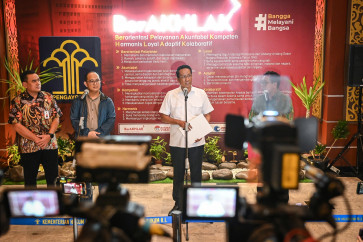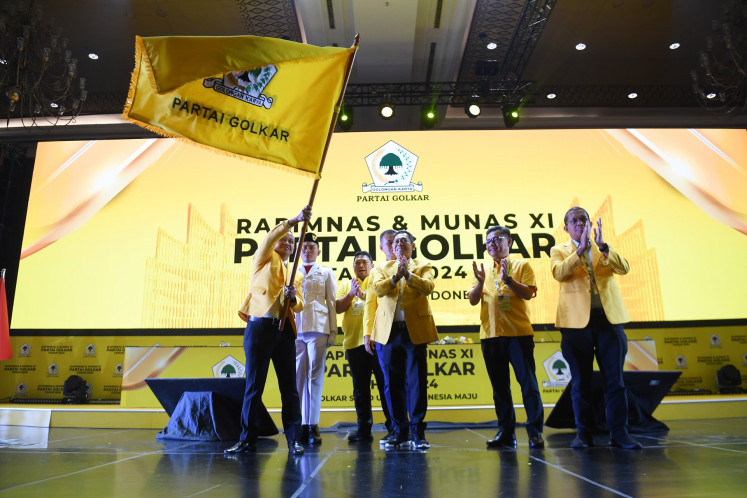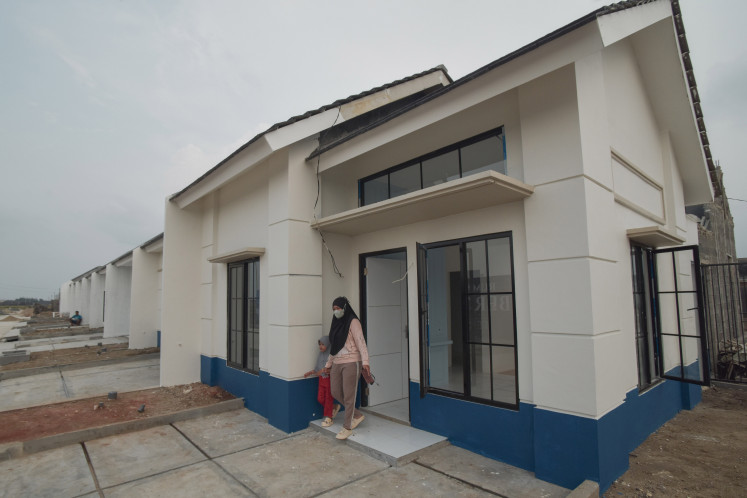Popular Reads
Top Results
Can't find what you're looking for?
View all search resultsPopular Reads
Top Results
Can't find what you're looking for?
View all search resultsBatik an evolving art form
It is only natural that the Indonesian people feel proud of their own unique batik
Change text size
Gift Premium Articles
to Anyone
I
t is only natural that the Indonesian people feel proud of their own unique batik. Batik is a highly artistic cultural heritage that enjoys wide appreciation.
This is further proven by the fact that batik has been included in the Representative List of the Intangible Cultural Heritage of Humanity by UNESCO.
But that is not all. Batik reflects the image of Indonesia as a nation with a highly developed culture and the arts. Therefore, it is a natural obligation for all of us to participate in preserving batik, the invaluable heritage of our forefathers.
There is no country in the world apart from Indonesia where batik is the highest expression of art. In almost every part of the Indonesian archipelago you can find various batik. One of the mostly hightly developed traditional batik originates from the island of Java.
Historically batik has been popular since the Majapahit kingdom and has been continuing to develop further during the subsequent kingdoms. Batik drawing using a special kind of wax that is later processed in a certain way has expanded and become a treasure of the Indonesian people since the end of 18th century.
The art of batik has gone through a long journey in Indonesian culture, starting from ornamental motifs on the walls of ancient temples to the most modern designs that compete in the international fashion world.
Talking of batik motifs and colors it must be acknowledged that there is some influence from foreign cultures. Initially, batik had limited designs and colors, some of which could only be worn by certain segments of society. However, the batik made in the coastal areas absorbed foreign influences from traders and the colonial powers.
Brighter colors, like red and so forth, have been popularized by the Chinese community. The Europeans living in Indonesian under the colonial government also had some role in influencing the batik motifs resulting in flowers, like tulips, and other items, such as buildings and horse carts. In spite of all these influences the traditional batik maintained its own motifs and remains the formal dress in traditional rites and rituals.
When one looks closely every single piece of batik cloth is different and you won’t be able to find two pieces that are exactly the same, especially the handmade ones. Indonesian batik is famous for its rich designs and unique motifs, the number of which keeps increasing due to the creativity of batik makers in this equatorial country.
The skill of batik making is developing rapidly here and in a number of Asian countries, such as Thailand, India, Malaysia, Iran and Sri Lanka. It is quite widespread in many parts of Asia as well as in other parts of the world. Still the renowned Indonesian batik still retains its popularity in the world.
Pekalongan batik is quite popular among batik lovers. Although there is no official record when Pekalongan batik began, it is estimated to have begun in the early 1800s. Some historical records mention that production in this area started in 1802 with the motif of a small tree.
To the east you will find batik made in Surakarta and Yogyakarta which have perfected the Mojokerto batik designs as well as those from Gresik, Surabaya and Madura, which all have their own unique features. To the west there has also been batik development in Banyumas, Kebumen, Tegal and Cirebon, which is a progressive development of the former Pekalongan batik.
Today batik has many forms and uses. Aside from long dresses and sarongs, which are the basic products, batik is also made into ready-to-wear dresses, shirts and so forth so that nowadays you don’t have to run to a tailor or a seamstress. You can also easily find bags, slippers, hats and wallets etc made from batik.
With all the rich designs and varieties of batik we should be proud to wear it as our daily attire. Indonesia is also famous for its richly designed handicrafts that reflect the unique culture of each region.
Handicrafts in Indonesia are usually made from either wood, rattan, batik, animal skin, leather, metal or a combination of one or two of these materials. These are made into attractive and unique souvenirs that you can give to friends or business relations or to decorate your home.
Foreign tourists often take back batik or handicrafts to their country. Today you don’t have to go far or to the remote areas to purchase such beautiful products, because in Jakarta you can easily find the batik cloth or handicrafts you are looking for.
Just visit the iconic department store Sarinah, a store which has played a leading role in preserving Indonesian traditional culture.
Indeed Sarinah has the mission to promote Indonesian batik and at the same time invites the public to appreciate and patronize this product. The management of Sarinah wishes that the public is aware that batik belongs to the Indonesian people. In line with that goal Sarinah continues to introduce batik to the public.
Sarinah collaborates with batik designers and suppliers that produce up to date designs and items. This is shown by the fact that both locals as well as foreigners like to shop at Sarinah. Also available are a wide range of beautiful items suitable for giving as gifts such as bags, wallets and so forth made by selected makers.
For the convenience of batik lovers Sarinah has opened several branches, namely in Yogyakarta, Malang, Semarang and Batam. Sarinah also plans to open more branches at a number of tourist destinations in Indonesia for easier consumer access and at the same time to absorb the production of batik and handicraft makers who are mostly micropreneurs.










